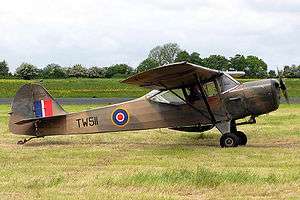No. 660 Squadron RAF
No. 660 Squadron was a Royal Air Force Air Observation Post squadron associated with the 21st Army Group during World War II. Numbers 651 to 663 Squadrons of the RAF were Air Observation Post units working closely with Army units in artillery spotting and liaison. A further three of these squadrons, 664–666, were manned with Canadian personnel. Their duties and squadron numbers were transferred to the Army with the formation of the Army Air Corps on 1 September 1957.[4][5]
| No. 660 Squadron RAF | |
|---|---|
| Active | 31 Jul 1943 – 31 May 1946 |
| Country | |
| Branch | |
| Role | Air Observation Post squadron |
| Motto(s) | No motto known[1] |
| Insignia | |
| Squadron Badge heraldry | No badge known[1] |
| Squadron Codes | BG (Aug 1945 – Apr 1946)[2][3] |
| Aircraft flown | |
| Reconnaissance | Auster Single-engined Army liaison monoplane |
History
Formation and World War II
No. 660 Squadron was formed at RAF Old Sarum on 31 July 1943[1] with the Auster III and in February 1944 the Auster IV. From November 1943, it was based at Hammerwood Park, a country house in Sussex. However, as the squadron's role was to support the Second British Army, in July 1944 it moved to France. Fighting in the break-out from Normandy it followed the army across the low countries and into Germany. The squadron disbanded at Holtenau, Germany on 31 May 1946.[6] The squadron today is represented by No. 660 Squadron AAC of the Army Air Corps, part of the (Defence Helicopter Flying School).
Aircraft operated

| From | To | Aircraft | Variant |
|---|---|---|---|
| July 1943 | February 1944 | Auster | Mk.III |
| February 1944 | May 1946 | Auster | Mk.IV |
| September 1944 | May 1946 | Auster | Mk.V |
References
Notes
- Halley 1988, p. 448.
- Bowyer and Rawlings 1979, p. 22.
- Flintham and Thomas 2003, p. 64.
- Halley 1988, pp. 444–451.
- Jefford 2001, pp. 102–104.
- Jefford 2001, p. 104.
Bibliography
- Bowyer, Michael J.F. and John D.R. Rawlings. Squadron Codes, 1937–56. Cambridge, UK: Patrick Stephens Ltd., 1979. ISBN 0-85059-364-6.
- Flintham, Vic and Andrew Thomas. Combat Codes: A full explanation and listing of British, Commonwealth and Allied air force unit codes since 1938. Shrewsbury, Shropshire, UK: Airlife Publishing Ltd., 2003. ISBN 1-84037-281-8.
- Halley, James J. The Squadrons of the Royal Air Force & Commonwealth 1918–1988. Tonbridge, Kent, UK: Air Britain (Historians) Ltd., 1988. ISBN 0-85130-164-9.
- Jefford, C.G. RAF Squadrons, a Comprehensive record of the Movement and Equipment of all RAF Squadrons and their Antecedents since 1912. Shrewsbury, Shropshire, UK: Airlife Publishing Ltd., 1988 (second edition 2001). ISBN 1-85310-053-6.
